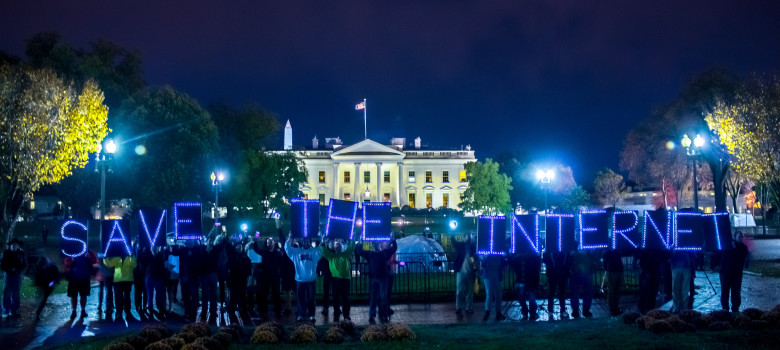One of President Barack Obama’s selling points for the TPP has been claims that it helps preserve “an open and free Internet.” The references to an open and free Internet, which is closely linked to net neutrality, may strike a chord with those concerned with digital issues. However, the Trouble with the TPP is that a close examination of the text and a comparison with existing net neutrality rules in many TPP countries reveals that it doesn’t advance the issue. In fact, the standards are so weak and unenforceable that at least half of the TPP countries already far exceed them.
Article 14.10 of the TPP provides:
Subject to applicable policies, laws and regulations, the Parties recognise the benefits of consumers in their territories having the ability to:
(a) access and use services and applications of a consumer’s choice available on the Internet, subject to reasonable network management;
(b) connect the end-user devices of a consumer’s choice to the Internet, provided that such devices do not harm the network; and
(c) access information on the network management practices of a consumer’s Internet access service supplier.
As a starting point, this is not mandated obligation. The TPP countries merely “recognize” the benefits of some net neutrality provisions. For those countries without net neutrality rules, there is no requirement to implement anything in order to comply with the agreement. In fact, if there was any doubt about the lack of enforceability, the entire provision is prefaced by the reference to “subject to applicable policies, and regulations.” In other words, the provision doesn’t advance anything for countries without net neutrality provisions.
For those with net neutrality provisions, the TPP typically falls well short of what they already have in place. In Canada, the CRTC’s Internet Traffic Management Practices go far beyond the TPP, offering more comprehensive coverage, a complaints mechanism, and enforceable obligations overseen by the CRTC. Many other TPP countries also have stronger net neutrality rules:
- The U.S. FCC net neutrality order prevents ISPs from blocking legal content, throttling on the basis on content, applications or services, and from charging content providers for paid prioritization.
- Peru adopted net neutrality rules in 2012, preventing ISPs from blocking interfering, discriminating, or restricting internet users from using an application regardless of its nature, origin or destination
- Mexico has passed amendments to its telecommunications legislation that adopt net neutrality.
- Singapore introduced a limited net neutrality policy in 2011 that prevents ISPs from blocking legitimate internet content, and forbids ISPs from imposing measures which effectively render content inaccessible or unusable.
- Chile has had net neutrality laws since 2010. The law requires ISPs “ensure access to all types of content, services or applications available on the network and offer a service that does not distinguish content, applications or services, based on the source of it or their property.
- Japan’s net neutrality policy is centred on fairness in network use with fairness in network cost sharing. Japanese ISPs have adopted packet shaping in order to insure consistent internet speeds, but recognize that packet shaping should be used a last resort, and ISP should focus on enhancing network capacity.
Net neutrality has also emerged as a policy issue in other TPP countries such as Australia and New Zealand. The net neutrality provisions may be promoted as a positive step forward by TPP supporters, but they are unlikely to have much, if any, impact.
(prior posts in the series include Day 1: US Blocks Balancing Provisions, Day 2: Locking in Digital Locks, Day 3: Copyright Term Extension, Day 4: Copyright Notice and Takedown Rules, Day 5: Rights Holders “Shall” vs. Users “May”, Day 6: Price of Entry, Day 7: Patent Term Extensions, Day 8: Locking in Biologics Protection, Day 9: Limits on Medical Devices and Pharma Data Collection, Day 10: Criminalization of Trade Secret Law, Day 11: Weak Privacy Standards, Day 12: Restrictions on Data Localization Requirements, Day 13: Ban on Data Transfer Restrictions, Day 14: No U.S. Assurances for Canada on Privacy, Day 15: Weak Anti-Spam Law Standards, Day 16: Intervening in Internet Governance, Day 17: Weak E-commerce Rules, Day 18: Failure to Protect Canadian Cultural Policy, Day 19: No Canadian Side Agreement to Advance Tech Sector)








quebec’s gambling takeover?
bell’s netflick squeeze?
the CRTC in general?
ISPs censoring labor, political and gay sites for fun and profit? (telus)
AND 80% of the traffic at one point was pirated movies….
The clause “(b) connect the end-user devices of a consumer’s choice to the Internet, provided that such devices do not harm the network” is the same kind of language that allowed Bell to prohibit plugging modems into “their” lines, and forced me top stick a telephone handset into an “acoustical coupler” and live with 300 baud.
And then there’s the matter of throttling VPN traffic. Or introducing small delays on, or blocking VoIP traffic.
Speaking of VPNs, the Canadian government (show of hands if you think the CRIA and their cronies had nothing to do with that) is looking into banning certain anonymous VPN services. And don’t think for a moment that with the TPP you get access to the full Netflix catalog, so no US or UK only shows.
Pingback: Links 30/1/2016: Neptune 4.5, *buntu 16.04 Xenial Xerus Alpha 2 | Techrights
Pingback: The Trouble With the TPP, Day 26: Why It Limits Canadian Cultural Policies - Michael Geist
Pingback: The Trouble With the TPP, Day 35: Gambling With Provincial Regulation - Michael Geist